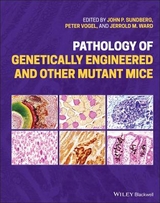
Genetically Engineered Mice Handbook
Seiten
2005
Crc Press Inc (Verlag)
978-0-8493-2220-4 (ISBN)
Crc Press Inc (Verlag)
978-0-8493-2220-4 (ISBN)
Zu diesem Artikel existiert eine Nachauflage
Covers pertinent aspects of genetically engineered mice, including the use of models for developmental biology and the monitoring of laboratory colonies. This work presents systematic approaches for analyzing mutant mice for medical applications, details methods for creating mutants and includes information dealing with legal responsibilities.
While mice have always been highly popular laboratory subjects, their suitability for genetic engineering has solidified their position as today's lab animal model of choice. However, their increased use in genetic studies has created a demand for input on phenotyping that is not always easily met.
To improve the flow of information on the pathology of mice with spontaneous or genetically engineered mutations, prominent researchers organized a series of meetings. Recognizing other needs, the organizers gradually broadened their focus, until finally they expanded to provide an overview of the entire field of genetically engineered models.
The Genetically Engineered Mice Handbook is an extension of those meetings. It offers an introduction for those entering into this area of research, while also serving as a resource for those presently employing mice as laboratory models. Highly comprehensive, this volume covers pertinent aspects of genetically engineered mice, including the use of models for developmental biology and the monitoring of laboratory colonies. With contributions from nearly five-dozen leading researchers, the text presents systematic approaches for analyzing mutant mice for specific medical applications, details a variety of methods for creating mutants and includes information that is particularly hard to access dealing with legal responsibilities.
This essential reference examines commonly used traditional, as well as emerging, technologies
To address the purpose of the original meeting, the Genetically Engineered Mice Handbook directs researchers to the best public websites, and offers instruction on how to use them. In the past, as their work dictated, researchers would seek out experts on particular organ systems. Now groups of experts work together to generate these websites, providing the latest data as well as discussions over points of debate. These sites do not eliminate the need for a trained pathologist, but they do provide reference materials for those lacking expertise in particular anatomic structures. They also offer much greater numbers of examples than are available in print, from which biomedical researchers can draw.
While mice have always been highly popular laboratory subjects, their suitability for genetic engineering has solidified their position as today's lab animal model of choice. However, their increased use in genetic studies has created a demand for input on phenotyping that is not always easily met.
To improve the flow of information on the pathology of mice with spontaneous or genetically engineered mutations, prominent researchers organized a series of meetings. Recognizing other needs, the organizers gradually broadened their focus, until finally they expanded to provide an overview of the entire field of genetically engineered models.
The Genetically Engineered Mice Handbook is an extension of those meetings. It offers an introduction for those entering into this area of research, while also serving as a resource for those presently employing mice as laboratory models. Highly comprehensive, this volume covers pertinent aspects of genetically engineered mice, including the use of models for developmental biology and the monitoring of laboratory colonies. With contributions from nearly five-dozen leading researchers, the text presents systematic approaches for analyzing mutant mice for specific medical applications, details a variety of methods for creating mutants and includes information that is particularly hard to access dealing with legal responsibilities.
This essential reference examines commonly used traditional, as well as emerging, technologies
To address the purpose of the original meeting, the Genetically Engineered Mice Handbook directs researchers to the best public websites, and offers instruction on how to use them. In the past, as their work dictated, researchers would seek out experts on particular organ systems. Now groups of experts work together to generate these websites, providing the latest data as well as discussions over points of debate. These sites do not eliminate the need for a trained pathologist, but they do provide reference materials for those lacking expertise in particular anatomic structures. They also offer much greater numbers of examples than are available in print, from which biomedical researchers can draw.
John P. Sundberg, Tsutomu Ichiki
Introduction and Overview. Creating Mutant Mice as Biomedical Tools. Legal Aspects of Mutant and Inbred Laboratory Mice. Repositories for Mutant Laboratory Mice. Information Repositories: International Databases. Approaches to Analysis of Mutant Laboratory Mice. Mouse Models for Developmental Biology. Infectious Diseases: Monitoring of Laboratory Mouse Colonies and Use in Genetic Engineering. Summary.
| Erscheint lt. Verlag | 2.11.2005 |
|---|---|
| Reihe/Serie | Research Methods For Mutant Mice |
| Zusatzinfo | 17 Illustrations, color; 97 Illustrations, black and white |
| Verlagsort | Bosa Roca |
| Sprache | englisch |
| Maße | 156 x 234 mm |
| Gewicht | 620 g |
| Themenwelt | Medizin / Pharmazie ► Medizinische Fachgebiete |
| Naturwissenschaften ► Biologie ► Genetik / Molekularbiologie | |
| Naturwissenschaften ► Biologie ► Zoologie | |
| ISBN-10 | 0-8493-2220-0 / 0849322200 |
| ISBN-13 | 978-0-8493-2220-4 / 9780849322204 |
| Zustand | Neuware |
| Informationen gemäß Produktsicherheitsverordnung (GPSR) | |
| Haben Sie eine Frage zum Produkt? |
Mehr entdecken
aus dem Bereich
aus dem Bereich
50 Meilensteine der Genetik
Buch | Hardcover (2022)
Librero b.v. (Verlag)
CHF 13,90



